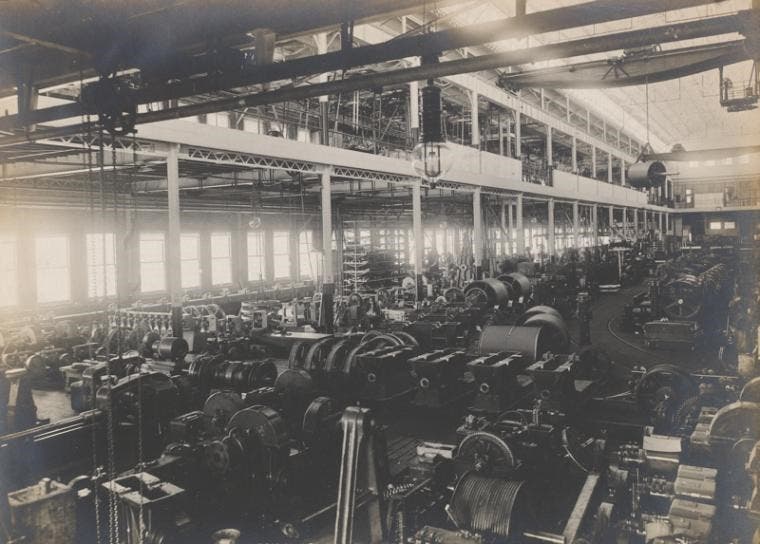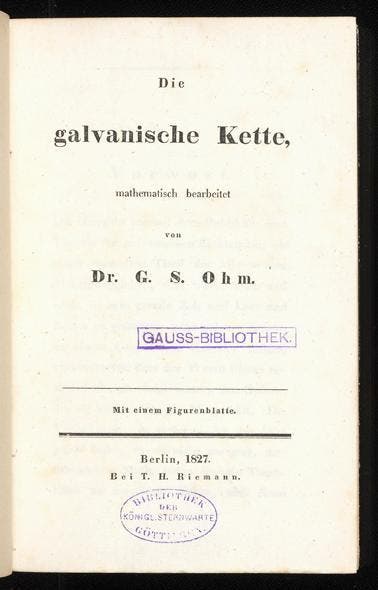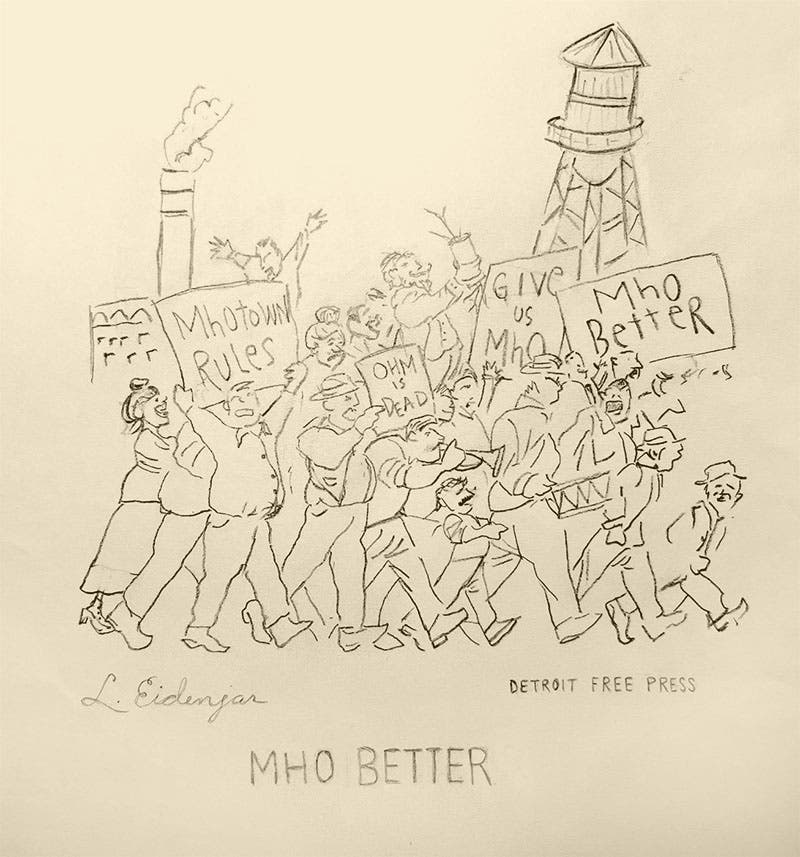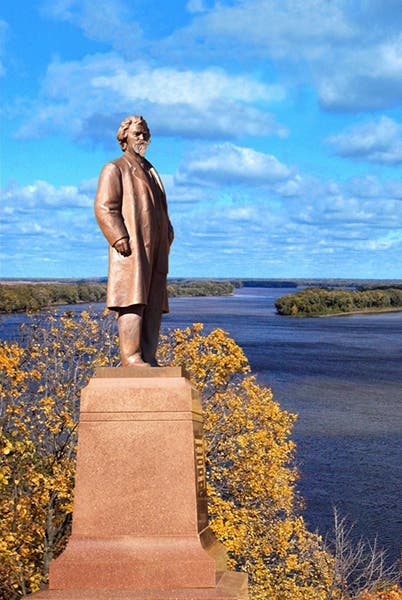Scientist of the Day - Mharvin Mho

Portrait of Mharvin Mho, hand-colored photograph, 1857, University of Michigan Libraries (lib.umich.edu)
Mharvin Mho, an American electrical scientist and manufacturer, was born Apr. 1, 1822. The odd spelling of his name was the result of an affectation of his father, Mhelvin Bharton Rhesus Mho, who founded the 4H Club movement in rural Michigan in the 1830s and changed his and his family’s names accordingly. Mharvin grew up with an interest in both electricity and railroads, which were sprouting throughout the Midwest as he grew up outside the settlement of Detroit.
Mho worked as a railroad conductor as a young man, and he thought it would be nice if the engineer had a way to communicate directly with the conductor in the caboose. So Mho devised an alphabetic code, using long and short whistle blasts, which he distinguished as WAH (long) and diddy (short). Each letter of the alphabet was a brief series of whistle blasts. So “T” was WAH, “E” was diddy, and “M” was diddy WAH diddy. The piece of cardboard on which he sketched out his first whistle alphabet still survives in the Michigan and Ohio Railroad Musesum (second image). Mho arranged it so that his own name, in code, was diddy WAH diddy, diddy WAH, diddy diddy, which had a nice beat to it. The code was very popular on the Michigan and Ohio railroad, and bystanders were delighted whenever a whistle message was sent – it almost set them to dancing. The coding system was subsequently appropriated by Samuel F.B. Morse for his new telegraph lines, with WAH and diddy becoming dah and dit, with no credit given to Mho. But in Michigan, it is still called Mho’s code.

“Possible whistle codes,” manuscript in the hand of Mharvin Mho, grey card stock, early 1840s, Michigan and Ohio Railroad Museum, Akron (morrm.com)
Mho wanted to apply electricity to solve railroad problems, such as signaling. For example, he designed automatic semaphores (there were no light bulbs yet), powered by batteries. As he tried to figure out what size batteries were needed for a signal, he realized that electricity was missing a unit. There was a unit for electrical potential (determined by the number of cells in a battery), which was popularly measured in volts. This was the analog to “head” or water pressure in hydraulics. And there was a unit for the amount of electricity being carried by a wire (analogous to the amount of water flowing in a pipe), which was measured in amperes. But what determined the amount of electricity a wire could carry, when hooked up to a battery of a specified voltage? There had to be something analogous to the size of a pipe in hydraulics. A large pipe could conduct a large quantity of water; so Mho came up with the quantity "conductance" for electricity. Some wires conduct more electricity than others. What if we had a unit for conductance, such that one unit of conductance allowed one volt to push one ampere through a wire. As an equation, it would look like this: V x C = A. Increase the conductance, and you increase the current. What to call such a unit of conductance? Mho was not especially modest; "mho" would do just fine. And he took to calling his law (V x C = A), Mho's law.
Unfortunately for Mho, a cabal of electrically minded scientists in England was not about to give credit to an American for discovering conductance. It was bad enough that the American Joseph Henry had tried to wrest priority for discovering electromagnetic induction from their own beloved Michael Faraday. In the 1860s, Charles Bright, Latimer Clark, and William Thomson, three prominent British electricians, were asked by the British Association for the Advancement of Science to come up with a set of standard units for electricity and magnetism (to go with standard units of length and weight). The committee was happy enough to standardize the volt and the ampere. But they were not going to allow a mho into the conversation. So they put their heads together and decided to invent a prior discoverer of the third factor in the V x C = A equation. They knew they couldn’t make him an Englishman, or suspicion would mount, and they might be found out. And they certainly were not going to give credit to the French for anything. But a German? That would be OK – English kings were German, after all So the committee announced that a German, George Ohm, had written a book on electricity in the 1820s in which he had proposed a unit of resistance (the inverse of conductance), and the committee suggested the ohm as a standard unit of electrical resistance (historians guess that they chose the name Ohm, and the unit ohm, because they couldn't resist playing with Mho's name, a jab across the ocean that no one would get except themselves and Mho). Mho’s law became Ohm’s law, and looked like this: V = A x R, where R = resistance = 1/C.

Interior of the Mho Rotor Factory, photograph, ca 1885, Engineering News, Mar. 27, 1887 (Linda Hall Library)
Since the committee proceedings were not published, Mho knew nothing about these shenanigans, and so he carried on with his electrical work, inventing a rotating power source that could change electricity into work, which he called a Mho rotor, eventually shortened to mhotor. The mhotor could replace the steam engine in many applications, and demand was high, at least in the United States. Mho built a factory to produce electrical mhotors and other electrical devices, just south of Detroit (third image). It was one of the most advanced factory towns in America, with worker housing integrated into the factory community. It even had a mhotorized walkway between the factory and the housing units, which was called the Mhoped. The community itself was usually referred to as either Mhotor-town or Mhotown, with the latter most common. Communication at the factory was entirely by Mho’s code whistles, and when you add in the loud hum produced by the transformers and magnetos in the factory, accented by a backbeat hammered out by the hydraulic presses, the result was a unique sound, which came to be known as the Mhotown sound. It would become deeply engrained in the region.
It was not until the late 1880s, when international congresses were being convened to standardize weights and measures for the world, that Mho heard about the British electrical standards committee, electrical resistance, and the ohm. Mho protested loudly and at length, mostly in American journals and newspapers. He demanded to see this book that no one had ever seen or heard of, by the mysterious George Ohm. Thomson (now Lord Kelvin) and his cohorts in intrigue commissioned an assistant to write a plausible manuscript and send it off to their friend Robert Bunsen in Berlin, where he had it printed up by a journeyman printer, and titled Die galvanische Kette, which they backdated to 1827. They only printed a small number of copies, since there was of course no market for it, and sent them off to Kelvin, who snuck copies into the British Library, the Bodleian Library, and Cambridge University Library (fourth image). Anyone now involved in rare book acquisitions for history of science libraries (as I was for many years) has always wondered why copies of Die galvanische Kette are so difficult to obtain, and then only at an exorbitant price, compared to comparable works by Ampere, Faraday, and Maxwell. Well, now you know. Forgeries are always expensive, especially when only a few were produced. We have never been able to snare a copy for our Library. And now, of course, with the Mho revelations, we don't want one.

Title page, Die galvanischie Kette, by George Ohm, supposedly 1827, but now known to be a be a fake imprint of the late 1880s (dealer's collection)
The defense of Mho on American soil was fierce. An international committee at the World’s Columbian Exposition in Chicago in 1893 declared that the international unit of resistance was to be the ohm, and the mho, as a unit of conductance, was to be an unofficial unit only. In response, there were widespread protests in Michigan, especially in Mhotown, with, on one occasion, Mhotowners parading through the streets, carrying the septuagenarian Mho on their shoulders, chanting, “We want Mho!” The Detroit Free Press captured the event with a powerful political cartoon, which they titled: "Mho better" (fifth image).

“Mho Better,” political cartoon by L. Eidenjar, Detroit Free Press, Nov. 3, 1893 (newspaperarchives.net)
The elderly Mho was told that, after he died, the town wanted to erect a statue in his honor as a memorial. Mho had no problem with that, but, being of a puckish disposition, he wanted the statue erected in St. Joseph, Missouri, where he had constructed a second mhotor plant, and he wanted the statue placed on a bluff overlooking the Missouri River. He wanted the plaque on the statue to read: "Mighty Mho meets Mighty Mo." His wishes were honored, and you can see the statue there today, near River Bluff Trails Park, in St. Joe’s (sixth image). But since the plaque was never installed, hardly anyone knows who it is.

Statue of Mharvin Mho, overlooking the Missouri River, St. Joseph, Missouri (photograph by Melissas Dehner)
The spelling reforms that overtook the United States in the early 20th century have wiped out much of Mho's legacy, so that we now speak of motors, Motown, the Motown sound, momentum, mopeds, and mojo, without realizing that all those words were derived from the work of Mharvin Mho. The mho, the unit of conductance, survived the longest, but now that it has been replaced by the siemens (what did Siemens ever do?), even that legacy has disappeared. Bo Diddley did write a song honoring Mho in 1956, which he called, cryptically to most, Diddy Wah Diddy. But otherwise, Mho is hardly known today. He deserves better. Mho better.
Thanks to Melissa Dehner and Ben Gross for help with this post.
William B. Ashworth, Jr., Consultant for the History of Science, Linda Hall Library and Associate Professor emeritus, Department of History, University of Missouri-Kansas City. Comments or corrections are welcome; please direct to ashworthw@umkc.edu.






